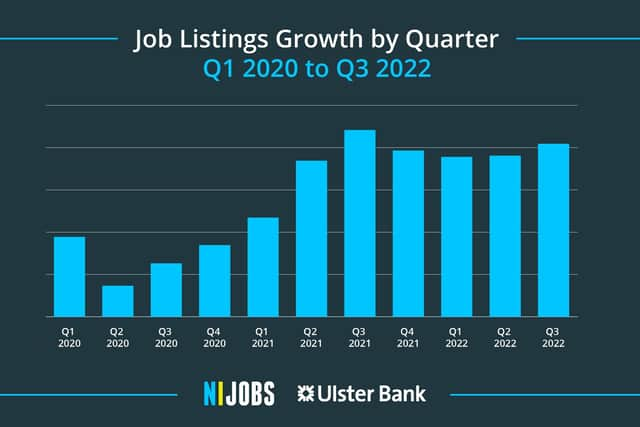Demand for staff high in NI despite rise in unemployment
and live on Freeview channel 276
Demand for Northern Ireland staff remains high despite a rise in official unemployment figures, according to the latest data from the NIJobs report with Ulster Bank.
Local employers are actively hiring with jobs 90% above the corresponding pre-pandemic quarter (Q3 2019) and five-and-a-half times the lockdown low of Q2 2020.
Advertisement
Hide AdAdvertisement
Hide AdJob vacancies listed on the NIJobs hiring platform rose by 6% in the latest quarter (Q3 2022) compared to the previous three months. Although, jobs have fallen back by 7% compared to the same time last year, which coincided with the lifting of lockdown restrictions in Q3 2021.
This rebalancing in the local recruitment market is not unexpected in the current climate of economic uncertainty and coming off the back of the record job highs of 2021.
The quarterly data and job listings from NIJobs.com are viewed as a leading indicator of labour market performance, giving insight into recruitment trends, the economic environment, and the types of roles jobseekers are searching for online.
Whilst employment levels have peaked, high numbers of people remain in roles and over half of NIJobs.com employment categories (16 out of 31) saw more positions advertised in the latest quarter than in Q2 2022.
Advertisement
Hide AdAdvertisement
Hide AdThe three sectors that saw the largest gains in the latest quarter were retailing, wholesaling & purchasing, hospitality and nursing, healthcare & medical.
Sam McIlveen, general manager at NIJobs.com, said: “While the economic environment may be uncertain, our current figures demonstrate that companies are actively recruiting. The easing of job listings must be viewed within the context of those record highs in 2021.
“There are jobs available, but it’s fair to say that the cost of living and energy crisis is impacting sectors that continue to experience skills shortages. Despite the recent increase in unemployment, the number of people in work remains high, which means the number of candidates available to recruiters is small, with employers targeting the same talent pool.
“All of this makes it a challenging hiring environment for employers who are also struggling to meet demand alongside soaring energy and wage bills.
Advertisement
Hide AdAdvertisement
Hide Ad“To try and tackle the current challenges, employers must be more diverse and flexible to meet their recruitment needs. It’s important to attract talent not only on salary terms but alongside a positive employee experience to boost retention.
“The latest Labour Force survey implies an increasing number of over 50s are returning to the workplace - this could partly be to top up their wages in the current cost of living crisis. This demographic could provide effective long-term solutions for both employees and
employers.
“Older employees could help tackle the shortages some sectors currently face, and they bring a wealth of skills, experience and expertise to the workplace.”
The return of an older workforce will play an important part in economic growth in an increasingly uncertain economic outlook.
Advertisement
Hide AdAdvertisement
Hide Ad

Richard Ramsey, Ulster Bank’s chief economist, believes we will likely see more of the economically inactive return to the workplace.
He added: “Those who can work may re-enter the workforce as household budgets become squeezed. In fact, we are already seeing it happen. The latest Labour Force survey shows an uptick in the numbers of economically actively workers aged 50+ compared to this time last year.
“Statistics released in September also revealed that the Northern Ireland economy contracted in Q2 for the first time in five quarters. More timely surveys, such as the Ulster Bank PMI, indicate that a second successive fall in output (signalling a ‘technical recession’) is on the cards in the third quarter. This downturn and deteriorating outlook will impact the labour market in due course. Indeed, the latest official statistics for September suggest that the labour market is on the turn.
“Employment may have peaked, but the number of job vacancies continues to climb. This highlights that there remains a significant amount of churn in the labour market.
Advertisement
Hide AdAdvertisement
Hide Ad“The hospitality sector saw a 24% quarter-on-quarter increase in job openings in Q3 2022, which is a reflection of labour shortages and churn rather than overall employment growth. Science, agriculture, pharmaceutical and food saw a similar-sized quarterly increase. This sector includes a number of Northern Ireland’s flagship pharma firms which are undergoing expansions. IT, which was the top employment category before the pandemic began, has witnessed its best six quarters to date during the last six quarters. IT jobs still account for one in 11 of all listings, while one in 10 is in hospitality.
“Nursing, healthcare and medical was only ranked 13th for the number of job listings before the pandemic (Q2 2019). Since Covid-19 arrived on the scene, however, the employment category has been ranked number one for the number of advertised vacancies. One in seven of all of the job vacancies advertised on the NIJobs.com platform fell under the Nursing, Healthcare & Medical category. This is well down on the peak of one in four of all vacancies in Q1 2021 and highlights some level of success in filling positions over the last 12 months.


“Given that CPI inflation is running at a 40-year high, wage rates rather than unemployment rates are still receiving more focus than normal. Northern Ireland’s median pay for employees increased by 5.5% y/y in September, a significant increase but well below the current CPI rate of 9.9% y/y.
“Autumn has brought with it huge increases in energy prices which have recently been compounded by a significant jump in mortgage interest rates. A cost of borrowing crisis is now a new variant of the cost-of-living crisis. For many, chasing a promotion, changing jobs, or seeking a different career have become a necessary response for cost-of-living reasons. In the war for talent, employers are having to up their game to attract and retain.”